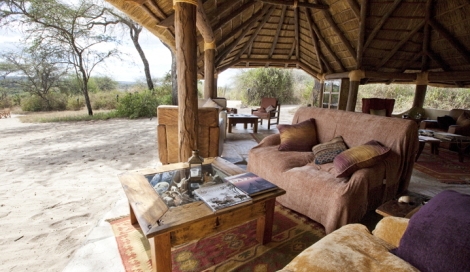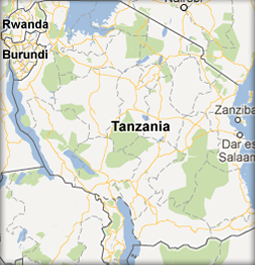
Oliver’s Camp is situated in the remote south-eastern part of the park, in the middle of Tarangire’s unspoilt wilderness.
Tarangire National Park is located in northern Tanzania, 120 km southwest of Arusha. The park is named after the Tarangire River that runs through the center of the park from south to northwest and drains into lake Burungi. Tarangire is known for its large herds of elephant and majestic baobab trees. You can find many of the large African mammals here, including lion, leopard, buffalo, and lesser and greater kudu. The park hosts an enormous variety of birds – more than 500 species.
Oliver’s Camp is ideally placed to access the yearly migrations of wildlife, and to view impressive concentrations at waterholes and in the spectacular Silale swamps. This area offers the best chance of seeing lion, leopard and cheetah and, especially during the dry season, the swamps are filled with elephant, buffalo and zebra. The camp is the perfect base to explore the busier baobab-country in the north of the park, but at the end of the day, guests return to the absolute exclusivity of Oliver’s Camp.
Accommodation
The camp features only 8 beautifully furnished guest tents. Solid wooden furniture, beautiful cloth and gorgeous warm showers that can be taken under the Tarangire sky. Every evening, guests relax or read in the lounge and library tent, or drink sundowners at the fireplace, from which superb views of landscape and sunset can be enjoyed
Oliver’s Camp’s crew has been a team for many years and as a result, a stay in camp feels like joining into a warm family. A family that will not only prepare amazing meals for you, but one that will also share with you a deeper knowledge of this stunning national park and its inhabitants.
Activities
The range of activities on offer at Oliver’s Camp is unique for a camp inside a Tanzanian National Park. Off-road driving makes wildlife drives more intense and interesting and allows you to get closer to the action. Walking and fly camping add another unique element to a safari that is hard to find in other parts of Tanzania. The park’s stunning natural beauty is ideal for wildlife and nature photography.
Game drives from Oliver’s Camp are usually carried out in open vehicles, giving a feeling of absolute freedom. Off-road driving, allowed only in the remote areas of the park, gets you closer to nature and wildlife.
Walking is the absolute specialty of Oliver’s Camp. The privilege of walking in these prime natural areas gives you exhilarating feeling of adventure. Walking safaris are very safe: the experienced naturalist guides of Oliver’s Camp avoid confrontations with animals (watching is not the same as disturbing!) and an armed national park ranger accompanies every walk.
The light weight fly camp is an extension of the main Oliver’s Camp. The fly camp is typically booked as part of a walking safari or simply as a completely private night away from the main camp. Fly camping is about adventure, not luxury: beds are comfortable and the crew cooks amazing meals in the middle of the wilderness, but tents are simple, with outside shower and bathroom facilities.
Seasons
Oliver’s Camp operates from June through to March. Although a visit during any of these months is very rewarding and excellent concentrations of game can be enjoyed year round, the park has distinct seasons. Note that the description of seasons below is of typical seasons: as in any part of the world, weather is unpredictable and in any particular season, the weather deviates from normal weather patterns.
JUNE AND JULY: In June the landscape is decked in wonderful wild flowers. Migrant birds have left for the north and wildlife has dispersed. The days are typically bright with some cloud cover and the mornings and evenings are quite cool.
It is the start of the dry season (or winter). The baobab trees are slowly losing their leaves, and after the wet season of April and May, plant life is at its most beautiful. But the signs of the dry season are starting to show. Some grasses are drying out, and, viewed from a high point, the land is a complex mosaic of green, brown and straw colored grass, with every shade of wildflower imaginable (particularly in June) decorating the landscape. It is very picturesque.
Wildlife viewing is unpredictable, but resident animals such as elephant, giraffe, lion and leopard, dikdik, impala and other smaller antelopes are usually easy to find. The large herds of zebra and wildebeest are now making their way into the park and, depending on the rainfall over the previous two months, are usually within the park boundaries by July.All in all, it’s a beautiful time to visit. Late July is an excellent time for long walks.
AUGUST TO OCTOBER: This is the dry season. The landscape becomes straw colored dotted with green-topped fig and acacia trees. The days are getting hotter and the mornings and evenings less cool. Normally, there is no rainfall during this period. Wildlife concentrations during these months are incredibly high and guests typically stay 3 or more days to enjoy the extraordinary variety. Water sources are shrinking and the grass is trampled down by thousands of hooves. Great herds of buffalo, zebra, wildebeest and elephant stay close to the last surface water. Bird life is also concentrated. Exploring the wilderness areas is easier, and we do just that. Lion prides are more sedentary and easier to find, and elephants are more concentrated. This time is possibly the best time to visit Tarangire and enjoy all the activities around Oliver’s base camp, especially walking, or fly camping near waterholes.
(LATE OCTOBER AND) NOVEMBER: Early October is very dry and wildlife viewing is excellent. There’s a slight humidity in the air, and this indicates that the rains are coming. By mid to late October some light showers typically arrive, and this is a real delight. Fresh new grasses sprout in days and wildlife thinks about moving. But it takes a few good downpours to disperse the herds. This state of flux can extend into November, and even December. Nature is waiting for the rain. It is a time of change, and as the land is refreshed a wonderful transformation takes place. Migrant bird species arrive and, as the grass is short, walking in this period is a delight – the flowers are back!
DECEMBER TO MARCH: It’s more humid and warmer at this time of year. By mid December the short rains have typically slowed; the land is regenerating and greenery returns. This is the start of the breeding season for much of this area’s wildlife, and our safaris concentrate on this spectacle. Elephants have extra energy and young mammals and birds fill the days with joy.
Our Tarangire, Crater & Serengeti safari includes a stay at Olivers Camp.




